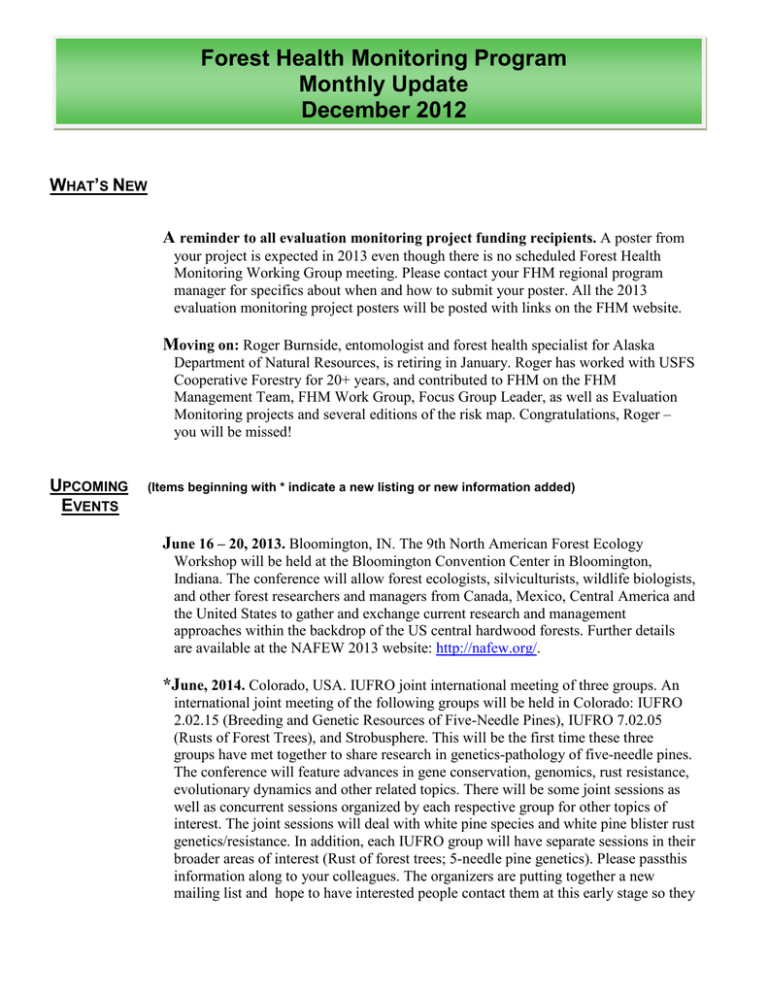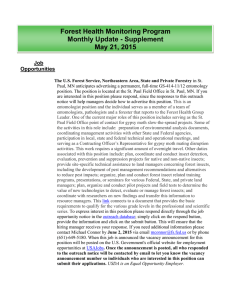Forest Health Monitoring Program Monthly Update December 2012 W
advertisement

Forest Health Monitoring Program Monthly Update December 2012 WHAT’S NEW A reminder to all evaluation monitoring project funding recipients. A poster from your project is expected in 2013 even though there is no scheduled Forest Health Monitoring Working Group meeting. Please contact your FHM regional program manager for specifics about when and how to submit your poster. All the 2013 evaluation monitoring project posters will be posted with links on the FHM website. Moving on: Roger Burnside, entomologist and forest health specialist for Alaska Department of Natural Resources, is retiring in January. Roger has worked with USFS Cooperative Forestry for 20+ years, and contributed to FHM on the FHM Management Team, FHM Work Group, Focus Group Leader, as well as Evaluation Monitoring projects and several editions of the risk map. Congratulations, Roger – you will be missed! UPCOMING EVENTS (Items beginning with * indicate a new listing or new information added) June 16 – 20, 2013. Bloomington, IN. The 9th North American Forest Ecology Workshop will be held at the Bloomington Convention Center in Bloomington, Indiana. The conference will allow forest ecologists, silviculturists, wildlife biologists, and other forest researchers and managers from Canada, Mexico, Central America and the United States to gather and exchange current research and management approaches within the backdrop of the US central hardwood forests. Further details are available at the NAFEW 2013 website: http://nafew.org/. *June, 2014. Colorado, USA. IUFRO joint international meeting of three groups. An international joint meeting of the following groups will be held in Colorado: IUFRO 2.02.15 (Breeding and Genetic Resources of Five-Needle Pines), IUFRO 7.02.05 (Rusts of Forest Trees), and Strobusphere. This will be the first time these three groups have met together to share research in genetics-pathology of five-needle pines. The conference will feature advances in gene conservation, genomics, rust resistance, evolutionary dynamics and other related topics. There will be some joint sessions as well as concurrent sessions organized by each respective group for other topics of interest. The joint sessions will deal with white pine species and white pine blister rust genetics/resistance. In addition, each IUFRO group will have separate sessions in their broader areas of interest (Rust of forest trees; 5-needle pine genetics). Please passthis information along to your colleagues. The organizers are putting together a new mailing list and hope to have interested people contact them at this early stage so they can more effectively plan the meeting. If you have ideas for the meeting, contact one of the individuals mentioned in the announcement or rsniezko@fs.fed.us. 2.02.15 – Breeding and genetic resources of five-needle pines http://www.iufro.org/science/divisions/division-2/20000/20200/20215/ 7.02.05 – Rusts of forest trees http://www.iufro.org/science/divisions/division-7/70000/70200/70205/ Strobusphere http://dendrome.ucdavis.edu/strobusphere/ JOB OPPORTUNITIES The USDA Forest Service Forest Health Protection will soon be advertising two positions: a GS 13 pathologist and a GS 13 entomologist in La Grande, Oregon. These positions are a part of Forest Health Protection, the Blue Mountains Service Center team which is currently staffed by two entomologists and one pathologist. Pathologist: Major duties include providing scientific advice to forest managers from all jurisdictions regarding forest diseases and cooperating and coordinating with other Forest Health specialists on matters of mutual interest. Major diseases in the Service Center area include Armillaria root disease, Heterobasidium annosum, Echinodontium tectorum, Phellinus weirii, many other conifer diseases and a variety of aspen diseases. The incumbent must be proficient in basic forestry, biological data collection and summarization, must be a proficient scientist, manager, and communicator, proficient in the use of computers, software, and other electronic equipment. Will be required to work in steep, uneven terrain under variable and inclement weather with significant overnight travel primarily between May and October. Entomologist: Major duties include providing scientific advice to federal land managers and the Confederated Tribes of the Umatilla Indian Reservation regarding forest insects and cooperating and coordinating with other Forest Health specialists on matters of mutual interest. Major pest insects in the Service Center area include western spruce budworm, Douglas-fir tussock moth, all the major western bark beetles, wood borers and aspen insects. The incumbent must be proficient in basic forestry, biological data collection and summarization, must be a proficient scientist, manager, and communicator, and proficient in the use of computers, software and other electronic equipment. Work is frequently in steep, uneven terrain under variable and inclement weather with significant overnight travel primarily between May and October. Duty station: Pacific Northwest Forestry and Range Sciences lab in La Grande, Oregon, a community of about 13,000 people and home to Eastern Oregon University. The area of primary responsibility roughly covers the region between the Snake River west to Heppner, Oregon, south to the Nevada border and north to Walla Walla and Pomeroy, Washington. This is an extremely diverse area including several mountain ranges, several Designated Wilderness areas, Wild and Scenic Rivers, range land and a variety of primarily conifer forests. You are encouraged to express your interest in our position by contacting Lia Spiegel at lspiegel@fs.fed.us, 541-962-6574. The vacancy announcements will be issued soon and will be posted on the Office of Personnel Management web page, http://www.usajobs.gov. USDA is an Equal Employment Opportunity Provider and Employer. The Idaho Department of Lands has an opening for a temporary Gypsy Moth Data Coordinator in the Coeur d’Alene Staff office. Responsibilities: plan, schedule, supervise, train, and direct activities of 1-2 temporary survey personnel in northern Idaho; develop and maintain databases necessary to accomplish program objectives; coordinate trapping activities with other state and federal agencies, including data collection, planning trap scheduling and placement; prepare cost estimates for upcoming field seasons; obtain records of annual costs for Gypsy Moth Survey Program by agency; utilize GIS programs to produce and edit maps and manipulate datasets to obtain desired results relative to survey program, including cases of suppression activities; communicate effectively with local landowners and other state and federal agencies to facilitate implementation of survey program; Utilize a wide variety of computer applications including database management, custom programs to model weather data and phenology and word processing; obtain and process monthly weather and related data to plan strategic trap locations; schedule and coordinate Idaho Gypsy Moth Technical Advisory Committee meetings annually, or as necessary; collect and analyze survey data, and produce and distribute annual Gypsy Moth Survey Report for Idaho; Analyze and submit Gypsy Moth Survey results to appropriate agency for input into IPHIS database; represent the State of Idaho and present annual program summary at Western and National Gypsy Moth Meeting, as necessary; read and interpret maps to locate specific trap sites; order trapping supplies based on projected trapping schedule each season; maintain data recorders in operating order; participate in and/or coordinate other insect and disease activities as needed, including other exotic pest surveys; conduct field work as needed to meet program objectives; assist with aerial detection surveys as an aerial observer, as needed; collect and process aerial detection survey results from state and federal partners. The position is open for recruitment December 5, 2012 – December 19, 2012, announcement #TEMP058486. Please send your resume and completed IDL Gypsy Moth Data Coordinator Temporary Application to the address in the full announcement or call Gina Davis at 208-666-8668 for further information. The complete job announcement and application can be found at http://www.idl.idaho.gov/bureau/administration/job.htm. Thank you for your interest in employment with the Idaho Department of Lands! Hiring is done without regard to race, color, religion, national origin, sex, age or disability. In addition, preference may be given to veterans who qualify under state and federal laws and regulations. If you need special accommodations to satisfy testing requirements, please contact the division of Human Resources. PUBLICATIONS OF INTEREST 1. Carlson, D.; Ragenovich, I. 2012. Silver fir beetle & fir root bark beetle. Forest Insect & Disease Leaflet 60. Revised April, 2012. FS/R6/RO/FIDL#60-12/001. Portland, OR: U.S. Department of Agriculture Forest Service, Pacific Northwest Region (R6). 8 p. Available online: http://www.fs.usda.gov/Internet/FSE_DOCUMENTS/fsbdev2_042843.pdf 2. Jovan, S.; Riddell, J.; Padgett, P.E.; Nash III, T.H. 2012. Eutrophic lichens respond to multiple forms of N: implications for critical levels and critical lads research. Ecological Applications. 22(7): 1910-1922. 3. Potter, K.M.; Conkling, B.L., eds. 2012. Forest health monitoring 2009 national technical report. Gen. Tech. Rep. GTR-SRS-167. Asheville, NC: U.S. Department of Agriculture Forest Service, Southern Research Station. Available online at: http://www.srs.fs.usda.gov/pubs/42261 4. Scott, D.W. 2012. Pine butterfly. Forest Insect & Disease Leaflet 66. Revised August, 2012. FS/R6/RO/FIDL#66-12/002. Portland, OR: U.S. Department of Agriculture Forest Service, Pacific Northwest Region (R6). 16 p. Available online: http://www.fs.usda.gov/Internet/FSE_DOCUMENTS/stelprdb5393938.pdf 5. Sniezko, R.A.; Yanchuk, A.D.; Kliejunas, J.T.; Palmieri, K.M.; Alexander, J.M.; Frankel, S.J., tech. coords. 2012. Proceedings of the fourth international workshop on the genetics of host-parasite interactions in forestry: Disease and insect resistance in forest trees. Gen. Tech. Rep. PSW-GTR-240. Albany, CA: Pacific Southwest Research Station, Forest Service, U.S. Department of Agriculture. 372 p. The proceedings and individual paper (pdfs) are at http://www.fs.fed.us/psw/publications/documents/psw_gtr240/ 6. USDA Forest Service. 2011. National report on sustainable forests 2010. FS-979. Washington, DC: U.S. Department of Agriculture Forest Service. 145 p. 7. USDA Forest Service. 2012. Future of America’s forests and rangeland Forest Service 2010 Resources Planning Act Assessment. GTR-WO-87. Washington, DC: U.S. Department of Agriculture Forest Service. 197 p. FOR MORE FHM INFORMATION Visit the FHM homepage: www.fs.fed.us/foresthealth/fhm/ or access via the USDA Forest Service homepage at www.fs.fed.us

